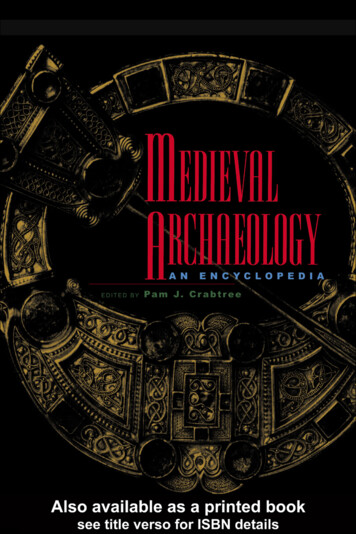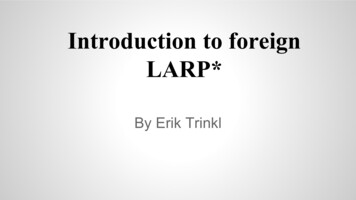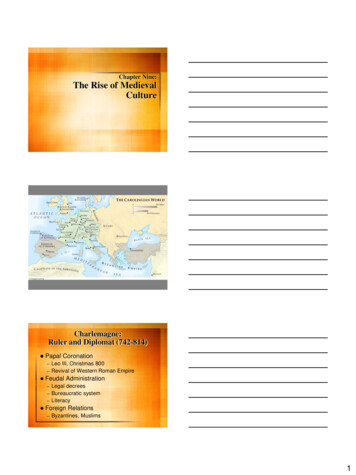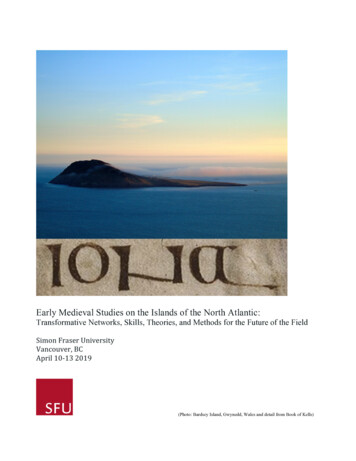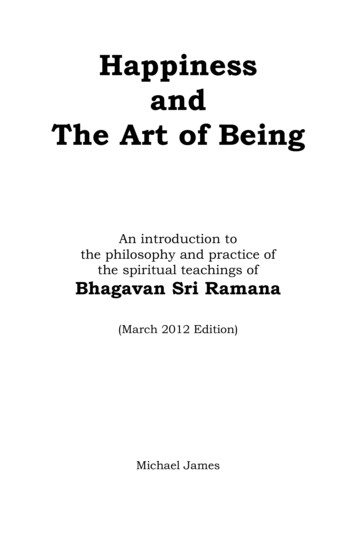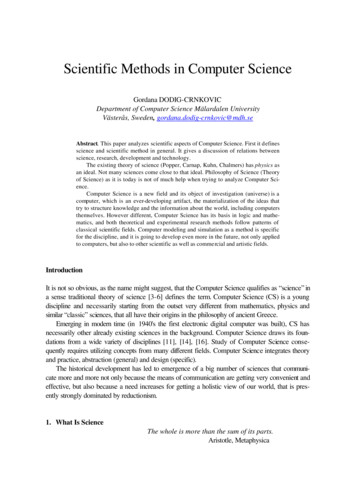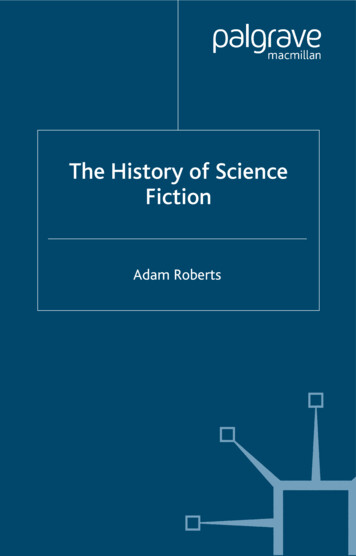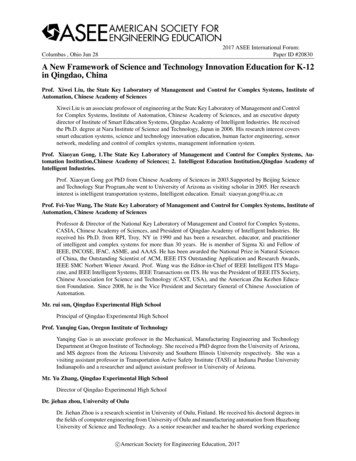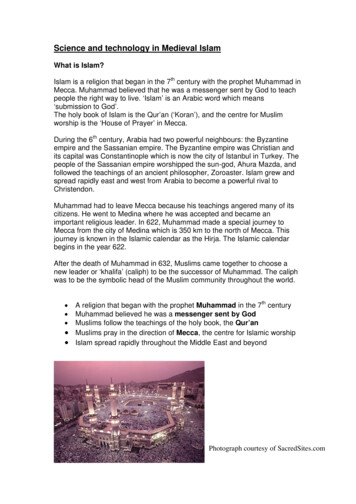
Transcription
Science and technology in Medieval IslamWhat is Islam?Islam is a religion that began in the 7th century with the prophet Muhammad inMecca. Muhammad believed that he was a messenger sent by God to teachpeople the right way to live. ‘Islam’ is an Arabic word which means‘submission to God’.The holy book of Islam is the Qur’an (‘Koran’), and the centre for Muslimworship is the ‘House of Prayer’ in Mecca.During the 6th century, Arabia had two powerful neighbours: the Byzantineempire and the Sassanian empire. The Byzantine empire was Christian andits capital was Constantinople which is now the city of Istanbul in Turkey. Thepeople of the Sassanian empire worshipped the sun-god, Ahura Mazda, andfollowed the teachings of an ancient philosopher, Zoroaster. Islam grew andspread rapidly east and west from Arabia to become a powerful rival toChristendon.Muhammad had to leave Mecca because his teachings angered many of itscitizens. He went to Medina where he was accepted and became animportant religious leader. In 622, Muhammad made a special journey toMecca from the city of Medina which is 350 km to the north of Mecca. Thisjourney is known in the Islamic calendar as the Hirja. The Islamic calendarbegins in the year 622.After the death of Muhammad in 632, Muslims came together to choose anew leader or ‘khalifa’ (caliph) to be the successor of Muhammad. The caliphwas to be the symbolic head of the Muslim community throughout the world. A religion that began with the prophet Muhammad in the 7th centuryMuhammad believed he was a messenger sent by GodMuslims follow the teachings of the holy book, the Qur’an Muslims pray in the direction of Mecca, the centre for Islamic worship Islam spread rapidly throughout the Middle East and beyondPhotograph courtesy of SacredSites.com
Science and technology in Medieval IslamThe “Golden Age” of Medieval IslamEarly Islam spread rapidly from its centres in the Middle East to the west toCairo (Egypt), across North Africa and into southern Spain, and to the eastthrough Persia (now Iran) towards Asia. The period of approximately 750 to1050 AD was a “golden age” for the Islamic world. Muslim scholars andscientists made great developments and discoveries. building on theachievements of previous civilisations.The first dynasty of caliphs, or Muslim rulers, was the Umayyad who ruledfrom Damascus in Syria. They were replaced by the Abbasid caliphs in 749who ruled for the next 500 years from Baghdad in Iraq.Arabia was at the crossroads between Asia, Africa, and Europe and the Arabpeople traded widely with merchants from places as diverse as China, Indiaand southern Europe. Trade and conquest led to cultural exchange and thespread of knowledge. The practical problems of trade over long distances alsoled to the development of techniques for navigation by the stars and a greaterunderstanding of time. Great centres of scholarship were established in citiessuch as Baghdad (in modern-day Iraq) and Alexandria. Islam spread rapidly with the conquests of the first caliphs, or Muslimrulers750-1050 AD was a “golden age” for the Islamic worldArabia was at the crossroads of trade between Asia, Africa and EuropeTrade and conquest led to cultural exchange and the spread ofknowledgeCities like Baghdad and Alexandria became great centres eopolitical.htm
Science and technology in Medieval IslamScience and Learning in Medieval IslamEarly Islamic teaching encouraged and promoted the pursuit of scholarshipand science. Seeking knowledge about the natural world was seen as theduty of every Muslim as the following Hadith (sayings of the ProphetMuhammad) show:‘He who pursues the road of knowledge, Allah will direct to the road ofParadise ’ (From Science in Medieval Islam by H. Turner)‘The scholar’s ink is holier that the martyr’s blood ’Things that improved the quality of life, like science and technology, wereencouraged and welcomed. These included practical things like navigationalaids for travellers, geographical maps, medical knowledge, ways of measuringand calculating, and tools for agriculture.The use of paper and books was very important in sharing and promotingknowledge in early Islam. The Muslims learned how to make paper fromChinese papermakers, and a paper mill was built in Baghdad. A huge bookindustry was established and there were bookshops and important libraries incities right throughout the Islamic empire. Wealthy patrons promoted thisindustry by buying expensive books, often lavishly illustrated, for their ownprivate family libraries.A new unified Arabic language was developed which became the language ofinternational scholarship. Muslim scholars in institutions such as ‘The Houseof Wisdom’ in Baghdad translated many important works from Greek, Latinand other languages. This helped to preserve important philosophical andscientific works from the ancient world, and to transmit this learning toEuropean scholars in the late Medieval period. In the 10th century a hugelibrary was established in Cairo with thousands of books about the ancientsciences. Early Islamic teaching encourage the pursuit of all knowledge thathelped to improve people’s livesArabic became the international language of scholarshipMuslims translated important works from ancient Greece and EgyptHuge libraries were established in big cities like Baghdad, Cairo andDamascus
Science and technology in Medieval IslamAstronomyAstronomy was important to Muslims for very practical and religious reasons:Astronomy aided navigation for purposes of trade and travel, and it wasimportant in determining an accurate lunar calendar, prayer times and thedirection of Mecca. Important Islamic observatories were established in manycities across the Islamic world in order to make accurate observations of thesun, moon and stars. Accurate calendars were important to determinereligious festivals such as the period of fasting known as Ramadan.Islamic astronomers developed new and improved instruments forobservation such as the astrolabe and quadrant. Astronomers such as Al-Tusiand Al-Farghani, as distinguished astronomer of the House of Wisdom, wrotesignificant books on astronomy which were later translated into Latin andinfluenced European astronomers such as Copernicus and Galileo. Astronomy was important to Muslims for practical reasonsAstronomy contributed to navigationObservations of the sun and moon were used to determine prayertimes and an accurate calendar Large observatories were established and new instruments such asthe astrolabe were developedImage of an Islamic observatoryThe Whipple Collection,Cambridge
Science and technology in Medieval IslamChemistry and AlchemyChemistry was not practised as a separate science in Medieval Islam, but itformed an important part of other industries such as metal-working, ceramicmanufacture, pharmacy and dyeing. A huge amount of practical knowledge ofsubstances and processes was gained. Important methods such as distillationwere developed by Islamic scientists, as well as new approaches toexperimentation. Islamic scientists were also the first to describe theproperties of acids and alkalis.Alchemy was widely practised and is often thought of as a precursor tochemistry. For Muslim alchemists, alchemy was a science of both the cosmosand the soul. Alchemists aimed to study processes of transmutation (changingsubstances), especially metals, and these processes were interpreted on aspiritual and symbolic level. Alchemy was a spiritual path in which nature wasregarded as sacred. It was also related to the practice of astrology anddifferent metals were linked with the qualities of different planets. This waspart of an integrated way of viewing the cosmos in which the meanings ofthings operated on many different planes, both material and spiritual.Alchemy later came into disrepute as it encouraged charlatans who claimedthey could make their employers rich by the transmutation of base metal intogold. Chemistry was not seen as a separate science, but was an importantpart of other industries and craftsIslamic scientists developed new experimental techniques andmethods such as distillationAlchemy was important as a science of the cosmos and the soulFigures of some AlchemicalProcesses in Arabic Manuscript
Science and technology in Medieval IslamMathematicsIslamic mathematicians developed the work of earlier Greek, Indian, Persianand Chinese mathematicians and made important advances.Muslim mathematicians were interested in number systems. They used twomain systems of numerals: the abjjad system which used letters of the Arabicalphabet to represent numbers, and the Hindu-Arabic numerals which is nowused in the West including zero. This replaced the awkward Roman numeralsystem in medieval times. They also borrowed a number system from theBabylonians which was based on 60, just like the minutes and seconds in ourtime system.Islamic theory of numbers was influenced by the Greek mathematician,Pythagoras, and viewed mathematics as having sacred significancesymbolising the inner reality of all things created by God. Number systemswere also important for practical things like measurement and moneycalculations in trade.Algebra first became a separate field of mathematics in Islam. The word“algebra” comes from the Arabic word “al-jabr” which means “restoringbalance” in an equation. The development of algebra allowed mathematiciansto represent numbers in the form of generalised symbols. Umar Khayyam,famous for his poetry, was an important mathematician who wrote a treatiseon algebra.Geometry was another important area of mathematics studied by Islamicmathematicians. The sacred science of geometry, the study of lines, shapesand spaces, was passed down to Islam from ancient Greek sources. Muslimscientists made important developments in both geometry and trigonometrywhich were useful in the study of astronomy and in practical arts such asarchitecture, and technologies such as the design of water wheels andfarming machinery. Islamic mathematicians built on the work of Greek, Indian, Persian andChinese mathematiciansIslamic mathematicians were interested in different number systemsDeveloped algebra and geometry which was important in architectureand other technologiesIslamic tile patternsused to decoratebuildings
Science and technology in Medieval IslamMedicine and surgeryIslamic medicine depended a great deal on knowledge of pharmacy, anatomyand surgery. Medical theory was combined with traditional herbal lore,alchemy and a huge range of material medica – natural materials used tocreate medicines. Like alchemy, medical theory was based on the Greekconcept of the four elements (Earth, Air, Fire and Water). These elementswere related to four ‘humours’, and disease was supposed to be caused by animbalance in the humours.Some of the first medical schools and hospitals were established in medievalIslam and were places of study and teaching as well as treatment. Theyprovided a model for later western hospitals.Under Islamic law dissections were forbidden, so Islamic knowledge ofanatomy was mostly derived from ancient Greece and other sources. Surgerywas generally a last resort, but some procedures such as cauterisation ofwounds were developed by Islamic physicians. Islamic medicine was based on the Greek model of the four elementsand ‘humours’ Disease was thought of as an imbalance of ‘humours’ Pharmacy, combining herbal medicine and alchemy, was important Islamic law forbade dissectionsIllustration from anatomicalwork.A miniature painting from aseventeenth centurymanuscript of Tashrih bi alTaswir, a treatise on humananatomy by Mansur binMuhammad.
Science and technology in Medieval IslamTechnologyThe dry and arid environment of Arab lands meant that it was important todevelop technologies especially for water and agriculture.Islamic engineering included reservoirs, aqueducts, water wheels andelaborate systems for irrigation. New knowledge of plants and natural historyalso contributed to agriculture.Islamic technology included paper-making, the manufacture of steel and othermetals, building and great technical advances in the tools and scientificinstruments. Arab lands were often dry and harsh environmentsImprovements in water technology were important for agriculture Other industries included manufacture of paper, machinery andscientific instrumentsWater raising machine from Al-Jazari manuscript
Science and technology in Medieval IslamWhy did the “Golden Age” come to an end?By the end of the 11th century the Islamic empire had become very large andtowards the end of the Abbasid Caliphate it began to crumble. Religiousdisagreements caused divisions between different groups and the Caliphsexerted more and more control over what was taught and where. Logic,rationalism and the philosopher of Aristotle began to make educated Muslimsmore sceptical and drew them away from orthodox religious beliefs. TheCaliphs became afraid that they would lose power and imposed a return toorthodox beliefs.Famously, a theologian by the name of Al-Ghazali argued in his book, TheDestruction of Philosophy, that reason should not be trusted and that it couldnot tell you anything about God. Science and philosophy was criticised and,he said, could lead to Hell. More and more, schools and academies wereforced to limit their teaching to theology. The sciences were divided intoapproved ‘Islamic sciences’ which were connected to religion, and ‘foreignsciences’.At the same time war began to weaken the empire. The European crusades(1097-1291) and attacks by the Mongols leading to the fall of Baghdad in1256 caused enormous destruction. Religious divisions caused problems by the end of the 11th centuryConservative theologians imposed a return to orthodox beliefs andrejected ‘foreign sciences’The European crusades and attacks by the Mongols weakened theempireCrusaders besiegingDamascus
Chemistry and Alchemy Chemistry was not practised as a separate science in Medieval Islam, but it formed an important part of other industries such as metal-working, ceramic manufacture, pharmacy and dyeing. A huge amount of practical knowledge of substances and pro
